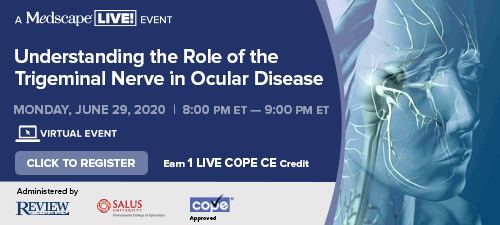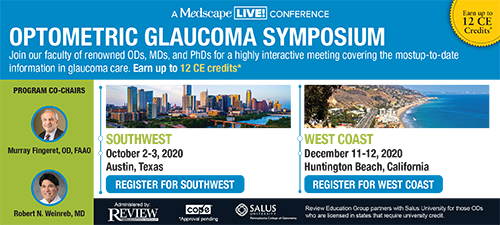
A
weekly e-journal by Art Epstein, OD, FAAO
Off the Cuff: The AOA, the FTC and Bureaucratic Idiocy
As many of you are likely aware, after four years of deliberation, the FTC has finalized changes to the contact lens rule. Before I discuss these idiotic and destructive additions to what was already a flawed and misguided assemblage of imbalanced and dysfunctional policies, I want to focus for a moment on the AOA and its role in this. Long-time readers will recall my very vocal opposition to the formation of the American Board of Optometry, which I still believe was a mistake. As the board certification issue became very heated, many readers assumed that the AOA and I would never see eye to eye again. However, that is simply not true. Yes, some of the AOA board members back then acted like vindictive jerks, but in the end, it had no real impact on me and I’ve long since moved past it. While my involvement as an active and visible AOA volunteer came to an end, my support for the AOA has been unflagging. I have remained a member throughout, and Shannon and I contribute to the AOA and AZOA PACs every year. As I see it, support for our AOA is more important than any professional disagreement—minor or major. Put simply, our profession cannot survive without a strong AOA. So, while I continued to call things as I saw them, and always will, I maintained backchannel connections. Earlier this year, I received a call from AOA Executive Director Jon Hymes. I’ve known Jon for many years. He is a major asset for optometry whom I have worked with before on a number of projects. As ED, Jon serves an exceptionally focused and visionary AOA Board of Trustees, led this past year by President Dr. Barbara Horn. Barb is a particularly intense and relentless advocate for our profession. Jon asked if I would be willing to fly to Washington DC to meet with the FTC to try to talk some sense into them regarding changes to the contact lens rule that they seemed hell-bent on implementing. Not one to turn down an opportunity to enlighten misguided bureaucrats, I didn’t hesitate, said yes, and booked my flights the same day. Along with the AOA Washington staff, I met with the FTC and shared some important new data. Understand that the FTC describes its mission as “protecting consumers by stopping unfair, deceptive or fraudulent practices in the marketplace.” I explained how the then proposed rule changes did exactly the opposite. They would promote fraudulent online sales activity by maintaining a flawed and much-abused passive verification process. The proposed changes were heavily biased against eye care providers, and added unnecessary and costly administrative burden that would do little to improve compliance. Finally, the new rules were primarily aimed at addressing a competitive problem that the marketplace had already resolved. The cost of contact lenses has dropped dramatically to the point where brick-and-mortar eye care offices are providing lenses at lower cost than online retailers. I am a tenacious and fairly skilled debater and I don’t give up, but it quickly became apparent that I was pleading my case to deaf ears. These bureaucrats had already made up their completely closed minds. You will be hearing a lot about the new contact lens rule in the coming days. I know it will frustrate many of you, and you will be as angry about it as I am. However, if any of you see this as an AOA failure, let me disabuse you of that notion. I thought I knew a fair amount about the inner workings of the AOA. I had no idea. The AOA’s presence in Washington DC, the coordination of volunteer colleagues coming from across the country who directly connect with lawmakers to keep us strong beyond our profession’s size at the federal level; and the staff’s dedication, their knowledge and commitment is incredible. The AOA even enlisted support from a bipartisan group of more than 100 US Senators and House members who came out strongly against these changes, but to no avail. See this clip and this one. Our AOA worked diligently to block this senseless, demeaning and destructive regulatory overreach, gaining more than four years delay to continue the battle. They didn’t fail for lack of effort, and I can assure you that they have not given up.Most of us have no idea of how much the AOA does for us behind the scenes. No association is perfect, but the AOA does more for optometry than any other organization. If you are not now a member, I urge you to join the AOA and your state association now. I know times are hard for many of us, but also supporting the AOA and your state association PAC is essential for our profession’s future. Finally, if you have developed, or are interested in developing, a relationship with a US Senator or Representative, it would be hugely helpful to the AOA and our profession. I can help connect you to the right AOA person. Expect to hear more about this FTC insanity. This isn’t over.
|
|||||
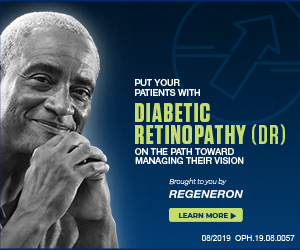 |
||
| Self-Retained Cryopreserved Amniotic Membrane for the Management of Corneal Ulcers | ||||
To evaluate the clinical outcomes of self-retained cryopreserved amniotic membrane (cAM) for the treatment of corneal ulcers, a single-center, retrospective review of consecutive patients with non-healing corneal ulcers that underwent treatment with self-retained cAM (PROKERA Slim) was conducted. The primary outcome measure was time to complete corneal epithelialization. Ocular discomfort, corneal staining, corneal signs and visual acuity were assessed at one week, one month, three months and six months. Complications, adverse events and ulcer recurrence were also recorded. A total of 13 eyes (13 patients) with recalcitrant corneal ulcers were included for analysis, nine (69%) of which progressed from neurotrophic keratitis (NK). Prior to cAM application, patients used conventional treatments such as artificial tears (n=11), antibiotics (n=11), ointment (n=11), steroids (n=6) and antivirals (n=3). Self-retained cAMs (n=1.5 ±0.8) were placed for 6.8 ±3.4 days, during which time antibiotics were continued. Four cases (31%) were subsequently treated with bandage contact lens (n=3) and tarsorrhaphy (n=1). All corneal ulcers healed in a median of 14 days (range: 4 to 43). This was accompanied by a significant improvement in ocular discomfort, corneal staining and corneal signs at one week, one month, three months and six months. Recurrence was noted in one case. No adverse events were observed. |
||||
SOURCE: Brocks D, Mead OG, Tighe S, et al. Self-retained cryopreserved amniotic membrane for the management of corneal ulcers. Clin Ophthalmol. 2020;14:1437-43. |
||||
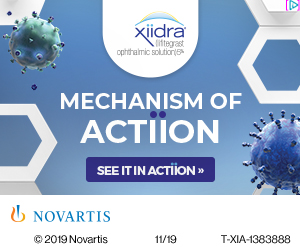 |
||
| Repeatability of the Pentacam HR in Various Grades of Keratoconus | ||||
A total of 20 healthy volunteers (20 eyes) and 69 patients (69 eyes) with keratoconus were enrolled in this study to evaluate the repeatability of an extensive number of relevant indices with the Pentacam HR in keratoconus of varying severity and normal eyes. Three consecutive measurements were performed by the same operator with Pentacam HR in keratoconus and normal eyes. Exclusion criteria included: past ocular surgery, recent rigid contact lens wear and corneal scarring. The keratoconus group was subdivided according to the Belin/Ambrosio total deviation value (BAD-D): subclinical, mild and moderate. The within-subject standard deviation (Sw) and repeatability limit (r) were computed for repeatability assessment. The tolerance index (TI) was calculated to compare across parameters with different measurement scales. For the sample size included, TI>0.36 signified statistical significance at the 0.05 level. Repeatability in subclinical keratoconus did not differ significantly from controls, except for wavefront aberrations. In mild keratoconus, 11/18 (61.1%) anterior corneal, 7/14 (50%) posterior corneal, 2/5 (40%) pachymetry, 7/11 (63.6%) combined and 1/6 (16.7%) densitometry parameters showed significantly worse repeatability compared to controls (TI>0.36). Repeatability of most parameters worsened in moderate disease. In particular, Kmax and anterior astigmatism showed significantly worse repeatability in moderate keratoconus. Investigators wrote that measurement variability of Pentacam HR is of clinical relevance when assessing for progression of keratoconus. They provided reference repeatability values and scale-independent analysis of relevant corneal parameters in keratoconus of varying degree.
|
||||
SOURCE: Kreps EO, Jimenez-Garcia M, Issarti I, et al. Repeatability of the Pentacam HR in various grades of keratoconus. Am J Ophthalmol. 2020; Jun 19;S0002-9394(20)30309-3. |
||||
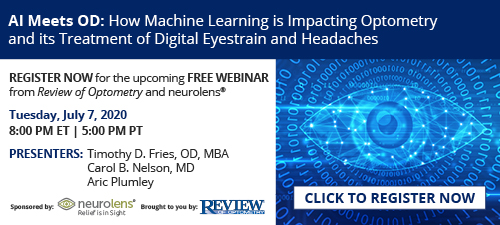 |
||
| The Myopic Shift in Aphakic Eyes in the Infant Aphakia Treatment Study After 10 Years of Follow-up | ||||
These researchers reported the myopic shift in the aphakic eyes of a cohort of children who underwent unilateral cataract surgery during infancy and were then followed longitudinally for 10.5 years. One-half of the children enrolled in the Infant Aphakia Treatment Study (IATS) were randomized to aphakia and contact lens correction after unilateral cataract surgery. They then underwent ocular examinations using standardized protocols at prescribed time intervals until age 10.5 years. Thirty of 57 children randomized to aphakia remained aphakic at age 10.5, having undergone unilateral cataract surgery at a median age of 1.6 (IQR: 1.1 to 3.1) months. The median refractive error (RE) in the 57 eyes randomized to aphakia immediately after cataract surgery was 19.01D (IQR: 16.98 to 20.49) compared to 10.38D (IQR: 7.50 to 14.00) for the 30 eyes that remained aphakic at age 10.5 years. The mean change in RE in aphakic eyes was -2.11D/year up to age 1.5 years, -0.68D/year from 1.5 to 5 years, and -0.35D/year from age five to 10.5 years. At age 10.5 years, 18 patients continued to wear a contact lens correction (silicone elastomer, n=6; gas permeable, n=6; hydrogel, n=5; and silicone hydrogel, n=1) (median RE, 12.50D), nine wore only spectacles (median RE, 4.00D), and four wore no correction (median RE, 11.25D) to correct their aphakic eye. The RE in aphakic eyes decreased by 44% from infancy to age 10.5 years. About two-thirds of children who remained aphakic at age 10.5 years continued to wear a contact lens.
|
||||
SOURCE: Lambert SR, Nizam A, DuBois L, et al. The myopic shift in aphakic eyes in the infant aphakia treatment study after 10 years of follow-up. Eye Contact Lens. 2020; Jun 18. [Epub ahead of print]. |
||||
 |
||
| News & Notes | ||||||||
| J&J Vision Donates $320K to Support Practitioners & Optometry Schools in Eye Care Services to COVID-19-Impacted Communities As part of ongoing initiatives to help support eye care in the wake of COVID-19, Johnson & Johnson Vision announced donations to Optometry Cares—The American Optometric Association (AOA) Foundation and the American Academy of Optometry Foundation (AAOF). As an AOA Recovery Partner, Johnson & Johnson Vision will make a donation to Optometry Cares, the charitable Foundation of the AOA, optometry’s philanthropic and charitable organization committed to expanding eye health and vision care access to everyone in the US in order to enhance human performance and quality of life. The donation will provide financial support to practitioners uniquely impacted by COVID-19 and help ensure eye care remains available in the wake of COVID-19. Johnson & Johnson Vision is also making a donation to the AAOF to support their efforts in procuring and distributing masks to practitioners and schools of optometry in the US, Puerto Rico and Canada. Read more. |
||||||||
|
||||||||
| Registration Open for NORA Online Conference Registration is now open for the Neuro-Optometric Rehabilitation Association, International (NORA) Online Conference, which will be available live online on Sept. 12–13. All presentations will be available on demand through Oct. 31. The NORA annual conference is a premier event for eye care and other health care professionals who provide rehabilitative services to individuals who have suffered a traumatic brain injury. This year’s program offers up to 17 COPE-approved CE credits in addition to new courses designed for optometrists looking to add a neuro-component to their office. Learn more and register here.
|
||||||||
|
Optometric Physician™ (OP) newsletter is owned and published by Dr. Arthur Epstein. It is distributed by the Review Group, a Division of Jobson Medical Information LLC (JMI), 19 Campus Boulevard, Newtown Square, PA 19073. HOW TO ADVERTISE |


